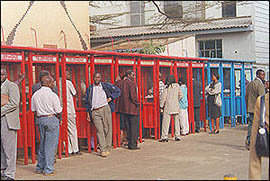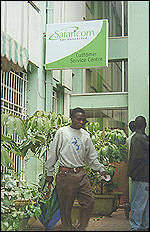 TELECOMMUNICATIONS: BRINGING KENYA INTO THE XXI CENTURY TELECOMMUNICATIONS: BRINGING KENYA INTO THE XXI CENTURY |

Making a simple telephone call has not always been so easy. In fact, Kenya's most demanding challenge is to bring up-to-date its telecommunications system. As part of the government privatization process and in order to make telecommunications more competitive by allowing the entrance of foreign telecom companies into the country, the former Kenya Posts & Telecommunications Corporation (KP&TC), was split into three entities in July 1999. The first one, the Communications Commission of Kenya (CCK), is the regulatory body. Secondly, the Postal Corporation of Kenya, will be a wholly owned government corporation in charge of postal services. Finally, Telkom Kenya Ltd., will be solely responsible of telecommunications.
Hon. Ndolo Ayah chairman of Telkom Kenya and former chairman of KP&TC, who was involved in the privatization of Kenya Airways as Minister of Transport, wants the privatization of Telkom to be a success. Since January 1999 they have been looking for strategic investors both nationally and internationally. The government will sale a first package of 26% of its Telkom shares to the chosen strategic partner. In one or two years a second package of 20% of the shares will be sold to the public through the NSE. Both Hon. Ayah and the former Minister of Transports and Communications, Hon.Ole Ntimama, agree that the strategic investor they are looking for has to bring in the expertise, the know-how, the management capacity, the money and the technology required to pump in some efficiency into the system.
 KENYA TELKOM, PLANNING THE FUTURE KENYA TELKOM, PLANNING THE FUTURE |
Indeed, efficiency is needed. Until now KP&TC did not have to worry, since they were a monopoly. But now that the whole situation has been altered the challenge to meet consumer expectations is enormous. There are 400,000 telephone lines in Kenya, out of which only 300,000 are operational. The waiting list of consumers to obtain a telephone line is of 120,000 people. These are only those that have expressed the desire to get a line, but there is probably double that amount that have not even bothered doing so, since the waiting time is several months. Mr. Cheserem, Managing director of Telkom Kenya, believes that the demand could be as high as 700,000 lines. "But with the lack of funding we have not been able to expand the net". In fact, continues Mr. Cheserem, "the penetration is only 1%, and in the Master Plan we have carried out, we have projected that by the year 2020 there should be 2.4 million lines operating in Kenya". The Master plan Mr. Cheserem talks about, projects the telecommunication requirements of Kenya up to the year 2015. The next three years will see the expansion and modernization of the network, with an estimated investment of US$ 2 billion.

Some steps have already been taken in order to keep up with the times, such as the creation of daughter companies to deal with the different aspects of telecommunications. Jambo Net is the Internet company supporting Internet Service Providers (ISP's) in Kenya. Before that ISP's had to operate though regular phone lines which was very costly. This has allowed reducing costs down 50-60%. | Safaricom was established as the mobile-phone company under KP&TC (now under Telkom). Safaricom has a subscriber base of 10,000 people but the waiting list is of 40,000 potential consumers eager to obtain a mobile phone. For that reason Telkom is already under discussions with British company Vodaphone, to start up a joint venture. Actually, 30% of Safaricom will be sold to Vodaphone. After this Kenya will be ready to allow the entry of the second mobile phone operator into the market.
 CCK AND THE SECOND MOBILE OPERATOR CCK AND THE SECOND MOBILE OPERATOR |
The licensing of the second cellular mobile operator is what is keeping the Communications Commission of Kenya (CCK) busiest. The pre-qualification process closed down in October 1999. 6 potential operators were selected from all continents (Egypt, England, India, etc). But the World Investment News Ltdr of the bid will not be announced until March, 2000. According to Mr. Chepkong'a, Director General, CCK explains that "the intention of licensing a second cellular mobile operator is to give consumers a wider choice and ensure that they get value for money". CCK's role is to act as the gateway and watchdog of the industry, in order to ensure that that the process is as transparent as possible. This they do by ensuring certain safeguards such as tariffs, interconnections issues, quality of service, etc.
The Managing Director of CCK, states that despite the advances to come in telecommunications, Africa mostly lacks the industrial base to service the sector. "There is a need to create an industrial base to support this important sector through deliberately supporting innovations of appropriate technology that we can easily adopt and utilize. We must ensure that we are not only customers to technology, but we must strive to make our countries producers of the same", stresses Mr. Chepkong'a. In fact, there is one enterprise in Kenya, Gilgil Telecommunications Industries (GTI), that is trying to do just that.
 GILGIL TELECOMMUNICATIONS, JOINT VENTURE WITH EUROPE GILGIL TELECOMMUNICATIONS, JOINT VENTURE WITH EUROPE |
Gilgil Telecommunications Industries Ltd, also known as GTI, was established in 1988 as a department of KP&TC. The assembly plant was built in order to provide this institution with telecommunications equipment such as simple telephones, letter boxes, phone booths, etc. Soon after GTI started diversifying its production incorporating high technology to produce computerized peripherals such as PABX (automatic switchboards), public switches etc. Today they have succeeded to capture 50% of all telecommunications equipment used in Kenya. Their success has been such that it has not been difficult for them to attract foreign investors. Ericson of Italy joined hands with GTI for the manufacturing of switching equipment. Their joint venture, called Erigtel, has already installed 25,000 lines and their objective is to manufacture 60,000 more by the end of 1999.
Kenya's neighbors, Uganda and Tanzania, have become their natural market. They have plans to continue exporting telecommunications equipment, transmission poles and accessories to Eastern and Central Africa,. Mr. Tanyasis, the proud Masai General Manager of GTI, says: "we will keep on playing a major role in terms of the supply of equipment to the liberalized market, which means not only Kenya, but also the entire East African Region and the COMESA zone. GTI aims to be a market leader in the region".
It should not be difficult. Kenya, jointly with the other two members of the East African Cooperation, Tanzania and Uganda, have agreed to undertake the East Africa Digital Transmission project, aimed at improving connectivity among the three countries. Being Kenya the current chairman of COMESA, Hon. Biwott, former Minister of East African and Regional Cooperation (present Minister of Tourism, Trade and Communications) has also been pushing the COMTEL project to be accepted by all member states. This project intends to harmonize telecommunication tariffs within the region by the year 2000, when COMESA will become a free trade area. Such development should not only increase connectivity, but also facilitate the development of trade and industry among member countries. |

